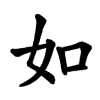Definify.com
Definition 2025
目
目
Translingual
| Stroke order | |||
|---|---|---|---|

| |||
Han character
目 (radical 109 目+0, 5 strokes, cangjie input 月山 (BU), four-corner 60101)
- Kangxi radical #109, ⽬ (“eye”).
Derived characters
- Index:Chinese radical/目
- 冒
References
- KangXi: page 798, character 25
- Dai Kanwa Jiten: character 23105
- Dae Jaweon: page 1213, character 21
- Hanyu Da Zidian: volume 4, page 2467, character 1
- Unihan data for U+76EE
Chinese
|
simp. and trad. |
目 | |
|---|---|---|
| alt. forms |
𥃦 𡇡 𥆤 |
|
Glyph origin
| Historical forms of the character 目
| |||
|---|---|---|---|
| Oracle bone script | Bronze inscriptions | Large seal script | Small seal script |
 |
 |
 |
 |
| Characters in the same phonetic series (目) (Zhengzhang, 2003) | |
|---|---|
| Old Chinese | |
| 瞐 | *mroːɡ |
| 苜 | *moːd, *muɡ |
| 目 | *muɡ |
Pictogram (象形) : stylized depiction of the human eye, rotated 90 degrees. Compare the Egyptian hieroglyph 𓁹.
Etymology
From Proto-Sino-Tibetan *s-mjak ~ s-mik. Cognate with Tibetan མིག (mig, “eye”), Burmese မျက် (myak, “eye, face”).
Pronunciation
- Mandarin
- Cantonese (Jyutping): muk6
- Hakka (Sixian, PFS): muk / mu̍k
- Min Dong (BUC): mĕk / mĕ̤k / mŭk
- Min Nan (POJ): ba̍k / bo̍k
- Wu (Wiktionary): moq (T5)
- Mandarin
- (Standard Chinese, Beijing)+
- Pinyin:
- Zhuyin: ㄇㄨˋ
- Wade-Giles: mu4
- Gwoyeu Romatzyh: muh
- IPA (key): /mu⁵¹/
-

- (Standard Chinese, Beijing)+
- Cantonese
- (Standard Cantonese, Guangzhou)+
- Jyutping: muk6
- Yale: muhk
- Cantonese Pinyin: muk9
- IPA (key): /mʊk̚²/
- (Standard Cantonese, Guangzhou)+
- Hakka
- (Sixian, incl. Miaoli and Meinong)
- Pha̍k-fa-sṳ: muk / mu̍k
- Hakka Romanization System: mug` / mug
- Hagfa Pinyim: mug5 / mug6
- IPA: /muk̚²/, /muk̚⁵/
- (Sixian, incl. Miaoli and Meinong)
- Min Dong
- (Fuzhou)
- Bàng-uâ-cê: mĕk / mĕ̤k / mŭk
- IPA (key): /miʔ⁵⁵/, /møyʔ⁵⁵/, /muʔ⁵⁵/
- Note: mĕk/mĕ̤k - colloquial; mŭk - literary.
- (Fuzhou)
- Min Nan
- (Hokkien)
- Pe̍h-ōe-jī: ba̍k / bo̍k
- Tâi-lô: ba̍k / bo̍k
- Phofsit Daibuun: bak, bok
- IPA (Xiamen): /bak̚⁴/, /bɔk̚⁴/
- IPA (Quanzhou): /bak̚²⁴/, /bɔk̚²⁴/
- IPA (Zhangzhou): /bak̚¹²¹/, /bɔk̚¹²¹/
- IPA (Taipei): /bak̚⁴/, /bɔk̚⁴/
- IPA (Kaohsiung): /bak̚⁴/, /bɔk̚⁴/
- Note: ba̍k - colloquial; bo̍k - literary.
- (Hokkien)
- Wu
- (Shanghainese)
- Wiktionary: moq (T5)
- IPA (key): /mʊʔ¹²/
- (Shanghainese)
- Dialectal data▼
| Variety | Location | 目 |
|---|---|---|
| Mandarin | Beijing | /mu⁵¹/ |
| Harbin | /mu⁵³/ | |
| Tianjin | /mu⁵³/ | |
| Jinan | /mu²¹/ | |
| Qingdao | /mu⁴²/ | |
| Zhengzhou | /mu²⁴/ | |
| Xi'an | /mu²¹/ | |
| Xining | /mv̩⁴⁴/ | |
| Yinchuan | /mu¹³/ | |
| Lanzhou | /mu¹³/ | |
| Ürümqi | /mu²¹³/ | |
| Wuhan |
/mu³⁵/ /moŋ³⁵/ |
|
| Chengdu | /mu³¹/ | |
| Guiyang | /mu²¹/ | |
| Kunming | /mu³¹/ | |
| Nanjing | /muʔ⁵/ | |
| Hefei | /məʔ⁵/ | |
| Jin | Taiyuan | /məʔ²/ |
| Pingyao | /mʌʔ⁵³/ | |
| Hohhot |
/məʔ⁴³/ ~的 /mu⁵⁵/ 眼~ |
|
| Wu | Shanghai | /moʔ¹/ |
| Suzhou | /moʔ³/ | |
| Hangzhou | /moʔ²/ | |
| Wenzhou | /mu²¹³/ | |
| Hui | Shexian | /mɔ²²/ |
| Tunxi | /mo¹¹/ | |
| Xiang | Changsha | /mo²⁴/ |
| Xiangtan | /mo²⁴/ | |
| Gan | Nanchang | /muʔ⁵/ |
| Hakka | Meixian | /muk̚¹/ |
| Taoyuan | /muk̚²²/ | |
| Cantonese | Guangzhou | /mok̚²/ |
| Nanning | /muk̚²²/ | |
| Hong Kong | /muk̚²/ | |
| Min | Xiamen (Min Nan) |
/bɔk̚⁵/ /bak̚⁵/ |
| Fuzhou (Min Dong) | /møyʔ⁵/ | |
| Jian'ou (Min Bei) | /mu⁴²/ | |
| Shantou (Min Nan) | /mak̚⁵/ | |
| Haikou (Min Nan) |
/mok̚³/ /mak̚³/ |
| Rime | |
|---|---|
| Character | 目 |
| Reading # | 1/1 |
| Initial (聲) | 明 (4) |
| Final (韻) | 屋 (4) |
| Tone (調) | Checked (Ø) |
| Openness (開合) | Open |
| Division (等) | III |
| Fanqie | 莫六切 |
| Reconstructions | |
| Zhengzhang Shangfang |
/mɨuk̚/ |
| Pan Wuyun |
/miuk̚/ |
| Shao Rongfen |
/miuk̚/ |
| Edwin Pulleyblank |
/muwk̚/ |
| Li Rong |
/miuk̚/ |
| Wang Li |
/mĭuk̚/ |
| Bernard Karlgren |
/mi̯uk̚/ |
| Expected Mandarin Reflex |
mù |
| Baxter-Sagart system 1.1 (2014) | |
|---|---|
| Character | 目 |
| Reading # | 1/1 |
| Modern Beijing (Pinyin) |
mù |
| Middle Chinese |
‹ mjuwk › |
| Old Chinese |
/*C.m(r)[u]k/ |
| English | eye |
Notes for Old Chinese notations in the Baxter-Sagart system: * Parentheses "()" indicate uncertain presence; | |
| Zhengzhang system (2003) | |
|---|---|
| Character | 目 |
| Reading # | 1/1 |
| No. | 9333 |
| Phonetic component |
目 |
| Rime group |
覺 |
| Rime subdivision |
1 |
| Corresponding MC rime |
目 |
| Old Chinese |
/*muɡ/ |
Definitions
目
- †(classical, archaic or Min) eye
- 目睭 [Min Nan] ― ba̍k-chiu [Pe̍h-ōe-jī] ― eye
- †eyesight
- † to look; to view; to see
- † to wink at
- † to judge; to comment on
- †opinion; viewpoint
- † to view as; to regard
- †hole; eyelet
- †item; entry
- †title; headline
- †section
- †list; catalogue; table of contents
- †name
- †target; goal
- †chief; head; leader
- (taxonomy) order
Synonyms
- (eye):
| Dialectal synonyms of 眼睛 (“eye”) | ||
|---|---|---|
| Variety | Location | Words |
| Classical Chinese | 目 | |
| Formal (Written Standard Chinese) | 眼睛 | |
| Mandarin | Beijing | 眼睛 |
| Jinan | 眼 | |
| Xi'an | 眼窩、眼睛 | |
| Wuhan | 眼睛 | |
| Chengdu | 眼睛 | |
| Yangzhou | 眼睛 | |
| Hefei | 眼 | |
| Cantonese | Guangzhou | 眼 |
| Hong Kong | 眼 | |
| Taishan | 眼 | |
| Yangjiang | 眼 | |
| Gan | Nanchang | 眼睛 |
| Hakka | Meixian | 目珠、眼珠 |
| Miaoli (N. Sixian) | 目珠 | |
| Liudui (S. Sixian) | 目珠、眼珠 | |
| Hsinchu (Hailu) | 目珠 | |
| Dongshi (Dabu) | 目珠 | |
| Zhuolan (Raoping) | 目珠 | |
| Yunlin (Zhao'an) | 目珠 | |
| Jin | Taiyuan | 眼睛、眼 |
| Min Bei | Jian'ou | 目睭 |
| Min Dong | Fuzhou | 目睭、目 |
| Min Nan | Xiamen | 目睭、目 |
| Taipei | 目睭、目 | |
| Chaozhou | 目 | |
| Wu | Suzhou | 眼睛、眼烏珠 |
| Wenzhou | 眼烏珠、眼靈珠、眼兒珠 | |
| Xiang | Changsha | 眼睛 |
| Shuangfeng | 眼珠 | |
Compounds
|
|
|
Japanese
Kanji
Readings
- Goon: もく (moku)
- Kan’on: ぼく (boku)
- Kun: ま (ma), め (me)
- Nanori: さかん (sakan), さがん (sagan), さっか (sakka), さつか (satsuka)
Etymology 1
| Kanji in this term |
|---|
| 目 |
|
ま Grade: 1 |
| kun'yomi |
Old Japanese. Older, unbound form of 目 (me2). Cognate with 見る (miru, “to see”). Never found in isolation in modern Japanese. Remains as the first syllable of various compounds.
Pronunciation
Noun
Derived terms
|
Etymology 2
| Kanji in this term |
|---|
| 目 |
|
め Grade: 1 |
| kun'yomi |
/me2/ *[məj] → /me/ [me]]. Compound of 目 (ma, unbound form) + い (i, emphatic nominal particle). Now the modern Japanese term for eye.
Pronunciation
Alternative forms
Noun
- eye
- 目がかゆいです。
- Me ga kayui desu.
- My eyes feel itchy.
- 目がかゆいです。
Derived terms
|
Suffix
- -st, -nd, -rd, or -th, for ordinal numbers (e.g. 8th or eighth, 9th or ninth)
- 三本目のボトル
- sanbon-me no botoru
- third bottle
- 三本目のボトル
Etymology 3
| Kanji in this term |
|---|
| 目 |
|
もく Grade: 1 |
| on'yomi |
From Middle Chinese 目. Go'on, so likely an older borrowed reading. Compare modern Cantonese 目 (muk6), or modern Wu 目 (/mʊʔ¹²/).
Pronunciation
Noun
- (taxonomy) an order in biology: smaller than a class, bigger than a family
- a playing piece in a board game, a stone in the game of go
- a point in the game of go
Derived terms
|
|
Verb
目する (hiragana もくする, romaji moku suru)
Conjugation
| Stem forms | ||||
|---|---|---|---|---|
| Imperfective (未然形) | 目し | もくし | moku shi | |
| Continuative (連用形) | 目し | もくし | moku shi | |
| Terminal (終止形) | 目する | もくする | moku suru | |
| Attributive (連体形) | 目する | もくする | moku suru | |
| Hypothetical (仮定形) | 目すれ | もくすれ | moku sure | |
| Imperative (命令形) | 目せよ¹ 目しろ² |
もくせよ¹ もくしろ² |
moku seyo¹ moku shiro² |
|
| Key constructions | ||||
| Passive | 目される | もくされる | moku sareru | |
| Causative | 目させる 目さす |
もくさせる もくさす |
moku saseru moku sasu |
|
| Potential | 目できる | もくできる | moku dekiru | |
| Volitional | 目しよう | もくしよう | moku shiyō | |
| Negative | 目しない | もくしない | moku shinai | |
| Negative continuative | 目せず | もくせず | moku sezu | |
| Formal | 目します | もくします | moku shimasu | |
| Perfective | 目した | もくした | moku shita | |
| Conjunctive | 目して | もくして | moku shite | |
| Hypothetical conditional | 目すれば | もくすれば | moku sureba | |
| ¹ Written imperative ² Spoken imperative | ||||
Etymology 4
| Kanji in this term |
|---|
| 目 |
|
ぼく Grade: 1 |
| on'yomi |
From Middle Chinese 目. Kan'on, so likely a later borrowed reading. Compare modern Min Nan 目 (bo̍k).
Only used in compounds.
Pronunciation
Affix
- an eye
- a look or appearance
Derived terms
|
References
- 1 2 2006, 大辞林 (Daijirin), Third Edition (in Japanese), Tōkyō: Sanseidō, ISBN 4-385-13905-9
- ↑ 1998, NHK日本語発音アクセント辞典 (NHK Japanese Pronunciation Accent Dictionary) (in Japanese), Tōkyō: NHK, ISBN 978-4-14-011112-3
Korean
Hanja
目 • (mok)
Eumhun:
- Sound (hangeul): 목 (McCune-Reischauer: mok, Yale: mok)
- Name (hangeul): 눈 (revised: nun, McCune-Reischauer: nun)
References
Okinawan
Kanji
Etymology
Cognate with mainland Japanese 目 (me, “eye”).
Noun
Derived terms
Southern Amami-Oshima
Kanji
Etymology
Cognate with mainland Japanese 目 (me, “eye”).